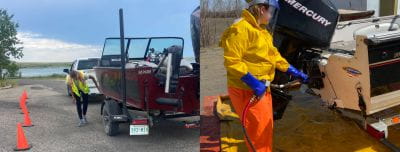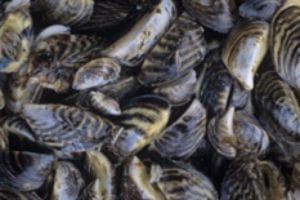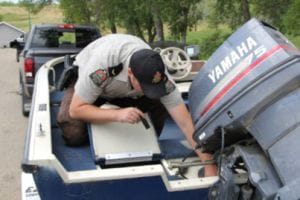Saskatchewan inspection stations are operated in the summer and early fall months during boating season by AIS watercraft inspectors and conservation officers. These watercraft inspectors are designated officers under The Fisheries Act (Saskatchewan) and have the ability to visually and physically inspect watercrafts and equipment, including interior compartments.
The inspection process is outlined below to give you an idea of what to expect when you encounter a mandatory watercraft inspection station.
Signage

- If a watercraft inspection station is open, the electronic sign board will read one of the following messages: “Mandatory Inspection Ahead,” “Boats Must Stop” or “Boats, Kayaks, Canoes”.
- Metal roadside signage will also be displayed shortly after, stating “Watercraft Inspection Station Ahead” with kilometre markers to advise you of your distance from the station.
- An “Invasive Mussel Inspection Station” sign may be present at the inspection location.
Failure to stop at a posted inspection station while operational can result in fines starting at $580.
Determination of risk
- Once you arrive at a watercraft inspection station you will be greeted by a uniformed watercraft inspector.
- Some of the questions required to assess the risk include:
- where the watercraft was last used;
- how many days the watercraft has been out of water; and
- if you have been previously inspected.
- Information is collected using digital tablets and is designed to help us assess risk and understand how watercraft are moving into and within the province.
Inspection
- Watercraft inspectors will visually and physically inspect all compartments and equipment within a watercraft during their inspection.
- Remember: canoes, kayaks, paddleboards and jet skis are all required to stop at watercraft inspection stations.
- Inspectors will be searching for visible aquatic invasive species, plants, mud, seeds, and standing water in all areas of the watercraft. This includes but is not limited to:
- anchors
- angling gear
- bilge areas
- hull
- life jackets
- live wells
- motor
- paddles
- ropes
- trailer
- wet storage compartments
- Standing water poses a serious risk due to the ability of microscopic aquatic invasive species to live in water or moist conditions for long periods of time and spread from one waterbody to another.
- Any gear that can stay moist – including ropes, anchors, life jackets and tubes – can transport microscopic invasive species unless fully cleaned and dried.
- A watercraft inspector may ask for your assistance to uncover the watercraft, raise/lower the engine, turn on bilge/live well/ballast pumps, and remove ballast bags and wet equipment from compartments.
Watercraft owners who have cleaned, drained and dried their watercraft and equipment typically pass through inspection stations quickly as they have removed most of the threat of spreading aquatic invasive species by following these best practices.

Decontamination
- If a watercraft inspector deems your watercraft to be high-risk and finds standing water, wet equipment, invasive mussels, or suspects aquatic invasive species may be present, they may complete a full or partial decontamination of your watercraft and/or equipment.
- Watercraft Inspectors complete decontaminations using hot water with temperatures ranging from 40°C to 60°C (120°F to 140°F). A low-flow diffuser hose is most often used to flush high-risk areas such as live wells or bilges with hot water.
- The combination of hot water and time on contact is effective at killing adult and larval aquatic invasive species such as zebra and quagga mussels.
- Watercrafts that contain ballast tanks and/or ballast bags and have been used out of province require a partial decontamination to remove standing water within the tanks/ballast bags.
Saskatchewan watercraft inspectors use HOT WATER ONLY when performing decontaminations. No chemicals, bleach, or other solutions are added to hot water rinses.
Quarantine
- Your watercraft may be temporarily quarantined if it is found to have aquatic invasive species. The quarantine period ensures all contaminated equipment has time to fully dry, further eliminating the risk of spreading viable, prohibited invasive species.
- If your watercraft has been quarantined, a seal will be affixed to the watercraft and trailer, and a quarantine order will be served stating the duration of the quarantine period.
- Watercraft may also be temporarily quarantined if they are unable to be fully inspected and/or decontaminated. Some examples of reasons for a temporary quarantine include:
- shrink-wrapped watercraft unable to be inspected; or
- unable to access all compartments of watercraft (retractable keel in sailboat).
- If a watercraft is issued a quarantine order due to the inability to fully inspect/decontaminate, the quarantine order will be in effect until a full inspection and/or decontamination can be completed.
Do not assume any watercraft is free of aquatic invasive species. It is your responsibility to inspect your own watercraft and gear after each use. Possessing or transporting prohibited aquatic invasive species, such as zebra mussels (dead or alive), is illegal and comes with potential fines starting at $500 and watercraft quarantine.




